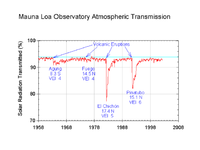
Photo from wikipedia
Abstract. Polar stratospheric clouds (PSCs) play a key role in polar ozone depletion in the stratosphere. Improved observations and continuous monitoring of PSCs can help to validate and improve chemistry–climate models… Click to show full abstract
Abstract. Polar stratospheric clouds (PSCs) play a key role in polar ozone depletion in the stratosphere. Improved observations and continuous monitoring of PSCs can help to validate and improve chemistry–climate models that are used to predict the evolution of the polar ozone hole. In this paper, we explore the potential of applying machine learning (ML) methods to classify PSC observations of infrared limb sounders. Two datasets were considered in this study. The first dataset is a collection of infrared spectra captured in Northern Hemisphere winter 2006/2007 and Southern Hemisphere winter 2009 by the Michelson Interferometer for Passive Atmospheric Sounding (MIPAS) instrument on board the European Space Agency's (ESA) Envisat satellite. The second dataset is the cloud scenario database (CSDB) of simulated MIPAS spectra. We first performed an initial analysis to assess the basic characteristics of the CSDB and to decide which features to extract from it. Here, we focused on an approach using brightness temperature differences (BTDs). From both the measured and the simulated infrared spectra, more than 10 000 BTD features were generated. Next, we assessed the use of ML methods for the reduction of the dimensionality of this large feature space using principal component analysis (PCA) and kernel principal component analysis (KPCA) followed by a classification with the support vector machine (SVM). The random forest (RF) technique, which embeds the feature selection step, has also been used as a classifier. All methods were found to be suitable to retrieve information on the composition of PSCs. Of these, RF seems to be the most promising method, being less prone to overfitting and producing results that agree well with established results based on conventional classification methods.
Journal Title: Atmospheric Measurement Techniques
Year Published: 2020
Link to full text (if available)
Share on Social Media: Sign Up to like & get
recommendations!